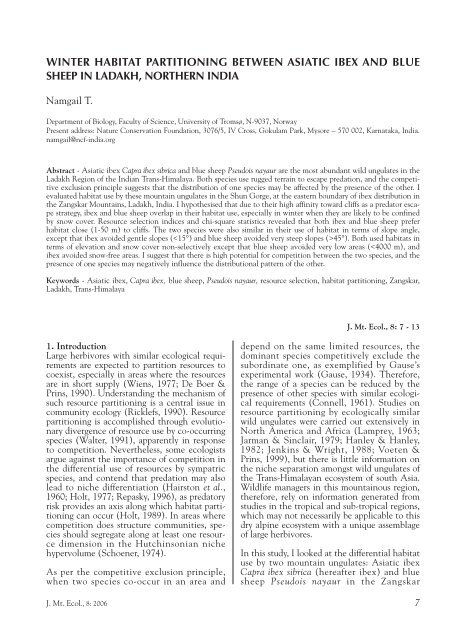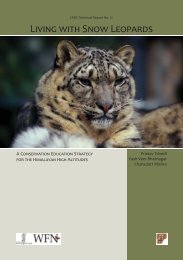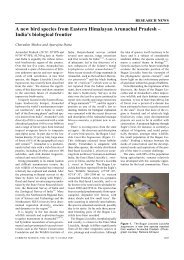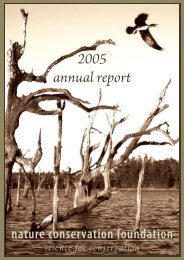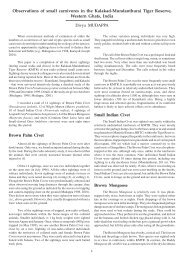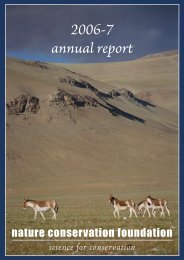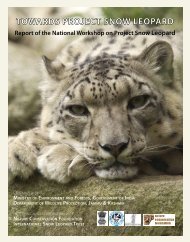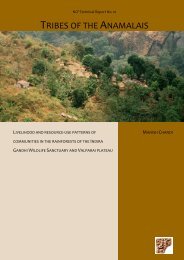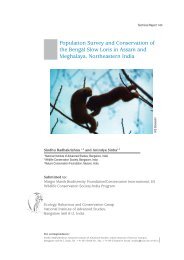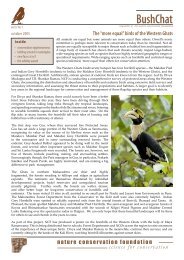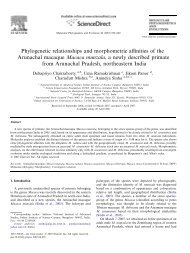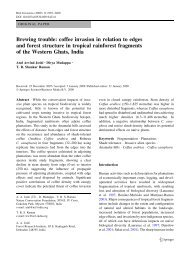Winter habitat partitioning between Asiatic ibex and blue sheep
Winter habitat partitioning between Asiatic ibex and blue sheep
Winter habitat partitioning between Asiatic ibex and blue sheep
Create successful ePaper yourself
Turn your PDF publications into a flip-book with our unique Google optimized e-Paper software.
WINTER HABITAT PARTITIONING BETWEEN ASIATIC IBEX AND BLUE<br />
SHEEP IN LADAKH, NORTHERN INDIA<br />
Namgail T.<br />
Department of Biology, Faculty of Science, University of Tromsø, N-9037, Norway<br />
Present address: Nature Conservation Foundation, 3076/5, IV Cross, Gokulam Park, Mysore – 570 002, Karnataka, India.<br />
namgail@ncf-india.org<br />
Abstract - <strong>Asiatic</strong> <strong>ibex</strong> Capra <strong>ibex</strong> sibrica <strong>and</strong> <strong>blue</strong> <strong>sheep</strong> Pseudois nayaur are the most abundant wild ungulates in the<br />
Ladakh Region of the Indian Trans-Himalaya. Both species use rugged terrain to escape predation, <strong>and</strong> the competitive<br />
exclusion principle suggests that the distribution of one species may be affected by the presence of the other. I<br />
evaluated <strong>habitat</strong> use by these mountain ungulates in the Shun Gorge, at the eastern boundary of <strong>ibex</strong> distribution in<br />
the Zangskar Mountains, Ladakh, India. I hypothesised that due to their high affinity toward cliffs as a predator escape<br />
strategy, <strong>ibex</strong> <strong>and</strong> <strong>blue</strong> <strong>sheep</strong> overlap in their <strong>habitat</strong> use, especially in winter when they are likely to be confined<br />
by snow cover. Resource selection indices <strong>and</strong> chi-square statistics revealed that both <strong>ibex</strong> <strong>and</strong> <strong>blue</strong> <strong>sheep</strong> prefer<br />
<strong>habitat</strong> close (1-50 m) to cliffs. The two species were also similar in their use of <strong>habitat</strong> in terms of slope angle,<br />
except that <strong>ibex</strong> avoided gentle slopes (45°). Both used <strong>habitat</strong>s in<br />
terms of elevation <strong>and</strong> snow cover non-selectively except that <strong>blue</strong> <strong>sheep</strong> avoided very low areas (
Namgail T.<br />
<strong>Winter</strong> <strong>habitat</strong> <strong>partitioning</strong> <strong>between</strong> <strong>Asiatic</strong> <strong>ibex</strong> <strong>and</strong> <strong>blue</strong> <strong>sheep</strong><br />
Mountains of Ladakh, India. These are the<br />
most abundant wild ungulates in the region<br />
with <strong>blue</strong> <strong>sheep</strong>’s population (c. 11,000 individuals)<br />
reaching almost double the number of<br />
<strong>ibex</strong> (Fox et al., 1991). Blue <strong>sheep</strong> also has a<br />
wider distribution in the region, mostly in the<br />
eastern part <strong>and</strong> <strong>ibex</strong> has a relatively narrower<br />
distribution in the western part (Fox et al.,<br />
1991). Fox et al. (1992), however, reported a<br />
relatively higher abundance of <strong>ibex</strong> in central<br />
Ladakh (despite its dryness <strong>and</strong> low vegetation),<br />
which they attributed to the lack of<br />
snowpack that might had encouraged <strong>ibex</strong><br />
populations to overwinter in the region. The<br />
two species constitute the most important prey<br />
species of the highly endangered snow leopard<br />
Uncia uncia (Mallon, 1991; Oli et al., 1993).<br />
Ibex <strong>and</strong> <strong>blue</strong> <strong>sheep</strong> have similar anti-predator<br />
<strong>habitat</strong> requirements, as both use rugged terrain<br />
to escape predation (Bhatnagar, 1997; Namgail<br />
et al., 2004). Preliminary observations on the<br />
<strong>habitat</strong> use by these species also revealed that<br />
they are similar in the use of <strong>habitat</strong> variables<br />
such as altitude, slope angle, rock type etc.<br />
(Mallon, 1991). Therefore, it is possible that<br />
they compete for some resources, <strong>and</strong> the presence<br />
of one species could negatively affect the<br />
other species. There is anecdotal information<br />
on their distributions that support such contentions,<br />
e.g., across large mountainous tracts of<br />
northwestern Tibetan Plateau, the distributions<br />
of these species demarcate often abrubtly, thereby<br />
suggesting competitive exclusion of one<br />
species by the other (Schaller, 1998).<br />
Blue <strong>sheep</strong> may use large boulders <strong>and</strong> scree of<br />
slate talus as escape terrain in parts of the<br />
Tibetan Plateau with low availability of cliffs<br />
(Harris & Miller, 1995). Furthermore, in other<br />
areas where the two species co-occur, <strong>blue</strong><br />
<strong>sheep</strong> are reported to explore the open slopes<br />
near cliffs more often than <strong>ibex</strong> (Wegge, 1989;<br />
pers. obs.). The former is therefore more flexible<br />
in its <strong>habitat</strong> use, <strong>and</strong> may have a competitive<br />
advantage over <strong>ibex</strong>. The Shun Gorge<br />
marks the eastern boundary of <strong>ibex</strong> distribution<br />
in the Zangskar Mountains of the Indian<br />
Trans-Himalaya (Namgail, 2004), while along<br />
the Himalayan Range to the south its eastern<br />
limit terminates abruptly at the Sutlej Defile<br />
(Fox et al., 1992). Based on the competitive<br />
exclusion principle, one can therefore speculate<br />
that competition with <strong>blue</strong> <strong>sheep</strong> may limit<br />
its eastward distribution. A study was thus carried<br />
out in the Shun Gorge to assess the degree<br />
of overlap <strong>and</strong> possible competition <strong>between</strong><br />
these ecologically similar species. Based on<br />
their similar anti-predator <strong>habitat</strong> requirements,<br />
I predicted a high overlap <strong>between</strong> the<br />
two species in the use of <strong>habitat</strong>, especially in<br />
winter when snow cover is likely to restrict<br />
them to limited grazing grounds.<br />
2. Methods<br />
2.1. Study area<br />
The Shun Gorge (33°N, 77°E) is located in<br />
the Zangskar Range, Ladakh, India, <strong>and</strong><br />
encompasses c. 70 sq. km. As other parts of<br />
Zangskar, it remains cut off from the rest of<br />
Ladakh in winter (Nov.-Apr.), when the only<br />
motorable road from Kargil is blocked by heavy<br />
snow. Thus during winter, it can only be accessed<br />
through a trek of c. 15 days over the frozen<br />
Zangskar, Lungnak <strong>and</strong> Tsarab rivers.<br />
Topographically, the area is characterised by<br />
rugged terrain, with low river bluffs along the<br />
Tsarab River. Elevation ranges from 3500-5000<br />
m. Precipitation is mostly in the form of snow<br />
during winter (Nov.-Feb.), <strong>and</strong> during the<br />
study period, I recorded about a meter of snow<br />
on the upper slopes.<br />
No ungulates are found in the area except the<br />
study species <strong>and</strong> domestic yak, horse, <strong>sheep</strong><br />
<strong>and</strong> goats. The <strong>sheep</strong> <strong>and</strong> goats were herded on<br />
the river bluffs near the villages, <strong>and</strong> were<br />
sometimes taken to the side-valleys, depending<br />
on the depth of snow. The yaks <strong>and</strong> horses<br />
ventured out far away from the villages but not<br />
far enough to disturb the <strong>ibex</strong> <strong>and</strong> <strong>blue</strong> <strong>sheep</strong>,<br />
which generally occurred on higher reaches.<br />
There are two villages viz., Yarshun (7 households)<br />
<strong>and</strong> Marshun (3 households) in the<br />
study area, with a total human population of c.<br />
50 people.<br />
Both wild <strong>and</strong> domestic ungulates are preyed<br />
on by the snow leopard, wolf Canis lupus<br />
chanku, <strong>and</strong> to a less extent by lynx Lynx l. isabellina.<br />
Avian predators like the golden eagle<br />
Aquila chrysaetos sometimes prey on the lambs<br />
of both domestic <strong>and</strong> wild ungulates. See<br />
Namgail (2004) for more information on wildlife<br />
<strong>and</strong> natural history of Zangskar.<br />
3. Field methods<br />
The study was conducted <strong>between</strong> 12 Jan. –20<br />
Feb. 2002. The length of the study period was<br />
constrained by the remoteness <strong>and</strong> inaccessibility<br />
of the study area. During the study, I<br />
walked on the frozen Tsarab River, looking for<br />
8 J. Mt. Ecol., 8: 2006
<strong>Winter</strong> <strong>habitat</strong> <strong>partitioning</strong> <strong>between</strong> <strong>Asiatic</strong> <strong>ibex</strong> <strong>and</strong> <strong>blue</strong> <strong>sheep</strong><br />
Namgail T.<br />
<strong>ibex</strong> <strong>and</strong> <strong>blue</strong> <strong>sheep</strong>. Two permanent trails: one<br />
upstream (c. 5 km) <strong>and</strong> one downstream (c. 3<br />
km) from Marshun Village were established on<br />
<strong>and</strong> along the river. Each trail was walked at<br />
least 15 times during the study period. The<br />
observations were aided by 8x40 binoculars<br />
<strong>and</strong> a 15-45X spotting scope.<br />
Whenever a group of animals was encountered,<br />
I recorded the time, date, species <strong>and</strong> <strong>habitat</strong><br />
characteristics such as distance to cliff, slope<br />
angle, elevation <strong>and</strong> snow cover. All these<br />
<strong>habitat</strong> variables were visually estimated except<br />
elevation, which was determined from a 1: 250,<br />
000 topographic map, <strong>and</strong> the accuracy was<br />
often checked by using a Global Positioning<br />
System (GPS). For estimating the proportions<br />
of available <strong>habitat</strong>, 149 r<strong>and</strong>om points were<br />
plotted on a 1: 250,000 topographic map of the<br />
area (Marcum & Loftsgaarden, 1980), which<br />
were then located on the ground <strong>and</strong> the <strong>habitat</strong><br />
characteristics at these sites were sampled<br />
in the same way as described for <strong>habitat</strong> use.<br />
4. Analytical methods<br />
The selection of <strong>habitat</strong> by <strong>ibex</strong> <strong>and</strong> <strong>blue</strong> <strong>sheep</strong><br />
were determined by estimating selection ratios<br />
(ratio of the proportion of <strong>habitat</strong> use <strong>and</strong> available)<br />
for different <strong>habitat</strong> units. The value of<br />
the selection ratio of a <strong>habitat</strong> unit is proportional<br />
to the probability of that unit being utilized<br />
by the study animals (Manly et al., 1993).<br />
Due to the small size of the study populations, I<br />
needed to include re-sighted groups in the<br />
analysis, but the long observation interval (one<br />
observation on a group/day) should minimise<br />
the autocorrelation. Since the available <strong>habitat</strong><br />
was estimated, <strong>and</strong> individual animals were not<br />
identified, the data conformed to the design I<br />
format (Thomas & Taylor, 1990) with sampling<br />
protocol A (Manly et al., 1993). For statistical<br />
analyses, the <strong>habitat</strong> variables were classified<br />
into distinct categories, <strong>and</strong> the selection<br />
ratio (w i ) for each category was calculated as<br />
Eqn. 1<br />
where o i is the proportion of used units in category<br />
i, <strong>and</strong> π i is the proportion of available<br />
resource units in category i. Subsequently, the<br />
st<strong>and</strong>ard error of a selection ratio was calculated<br />
as<br />
Eqn. 2<br />
where u i is the used resource units in category i,<br />
u + is the total number of used units sampled,<br />
m i is available resource units in category i <strong>and</strong><br />
m + is the total available units in category i.<br />
To statistically test for <strong>habitat</strong> selection, i.e.,<br />
whether sample proportion of used resource<br />
units were significantly different from the sample<br />
proportion of available units, the modified<br />
X 2 : log-likelihood Chi-square statistic ( XL<br />
2) for<br />
each <strong>habitat</strong> variable was calculated as<br />
Eqn. 3<br />
where E(u i ) is the expected value of u i , <strong>and</strong><br />
E(m i ) is the expected value of m i . If the XL<br />
2 was<br />
significant for a <strong>habitat</strong> variable (i.e., <strong>habitat</strong><br />
selection), simultaneous Bonferroni-adjusted<br />
95% confidence intervals were calculated for<br />
each category of that variable (to check which<br />
categories are creating the significance) as<br />
Eqn. 4<br />
where I is the number of <strong>habitat</strong> categories <strong>and</strong><br />
se (w i ) is the st<strong>and</strong>ard error of selection ratio.<br />
A <strong>habitat</strong> was used selectively, if the confidence<br />
limit for that <strong>habitat</strong> excluded 1. If selected,<br />
a <strong>habitat</strong> was preferred if the interval was > 1,<br />
<strong>and</strong> avoided if < 1 (Manly et al., 1993).<br />
Univariate t-tests were used to statistically test<br />
for significant differences in the use of <strong>habitat</strong><br />
in terms of distance to cliff, slope angle, elevation<br />
<strong>and</strong> snow cover by <strong>ibex</strong> <strong>and</strong> <strong>blue</strong> <strong>sheep</strong>.<br />
The slope angle <strong>and</strong> elevation were normally<br />
distributed, <strong>and</strong> the distance to cliff <strong>and</strong> snow<br />
cover were log <strong>and</strong> arcsine transformed, respectively.<br />
Overlap in <strong>habitat</strong> use by <strong>ibex</strong> <strong>and</strong> <strong>blue</strong><br />
<strong>sheep</strong> was calculated using Pianka’s index<br />
(Pianka, 1973).<br />
Eqn. 5<br />
J. Mt. Ecol., 8: 2006<br />
9
Namgail T.<br />
<strong>Winter</strong> <strong>habitat</strong> <strong>partitioning</strong> <strong>between</strong> <strong>Asiatic</strong> <strong>ibex</strong> <strong>and</strong> <strong>blue</strong> <strong>sheep</strong><br />
Tab. 1 - Estimated <strong>habitat</strong> selection indices for <strong>Asiatic</strong> <strong>ibex</strong> <strong>and</strong> <strong>blue</strong> <strong>sheep</strong> in Zangskar, Ladakh, India. w i estimated<br />
<strong>habitat</strong> selection ratio; se(w i ) st<strong>and</strong>ard error of selection ratio; w i (l) <strong>and</strong> w i (u) 95% lower <strong>and</strong> upper confidence<br />
limits, respectively.<br />
<strong>Asiatic</strong> <strong>ibex</strong><br />
Blue <strong>sheep</strong><br />
Variable w i se (w i ) w i (l) w i (u) w i se( w i ) w i (l) w i (u)<br />
Distance to cliff (m)<br />
0 0.560 0 0.198 0.116 1.004 0.322 – 0.125 0.042 0.602<br />
1-50 1.709 + 0.293 1.053 2.365 1.626 + 0.263 1.037 2.215<br />
51-100 0.560 0 0.262 0.000 † 1.147 1.030 0 0.322 0.309 1.751<br />
>100 0.689 0 0.375 0.000 † 1.529 0.792 0 0.351 0.006 1.578<br />
Slope angle (deg.)<br />
45 0.448 0 0.272 0.000 † 1.057 0.196 – 0.145 0.000 † 0.521<br />
Elevation (m)<br />
4300 0.560 0 0.347 0.000 † 1.337 0.490 0 0.273 0.000 † 1.102<br />
Snow cover (%)<br />
0 0.395 – 0.160 0.037 0.753 0.909 0 0.209 0.441 1.377<br />
1-25 2.239 0 1.047 0.000 † 4.584 0.736 0 0.436 0.000 † 1.713<br />
26-75 1.990 0 0.586 0.677 3.303 1.553 0 0.451 0.543 2.563<br />
>75 0.833 0 0.194 0.398 1.268 0.890 0 0.173 0.502 1.278<br />
+ (preference); – (avoidance); 0 use in proportion to availability; † inferences are less reliable due to very few observations<br />
(ui < 5).<br />
where O jk is the measure of overlap <strong>between</strong><br />
species j <strong>and</strong> k, <strong>and</strong> P ij <strong>and</strong> P ik are the proportions<br />
of time spent by species j <strong>and</strong> k respectively<br />
on resources i-n. Overlap is complete<br />
when O jk = 1 <strong>and</strong> absent when O jk = 0.<br />
5. Results<br />
Forty-six observations on <strong>ibex</strong> <strong>and</strong> 70 on <strong>blue</strong><br />
<strong>sheep</strong> were made during the study period.<br />
During surveys in the study area, I counted a<br />
maximum of 35 <strong>ibex</strong> <strong>and</strong> 67 <strong>blue</strong> <strong>sheep</strong>.<br />
Assuming that I counted all the animals in the<br />
c. 70-km 2 -gorge, the above figures translate to<br />
an <strong>ibex</strong> density of 0.5/km 2 <strong>and</strong> a <strong>blue</strong> <strong>sheep</strong><br />
density of 0.96/km 2 . Habitat selection pattern<br />
by the two species is given in Table 1, while<br />
Table 2 presents the means (± SE) of the <strong>habitat</strong><br />
variables used by the two species <strong>and</strong> their<br />
overlap.<br />
Habitat use <strong>and</strong> overlap<br />
Ibex preferred <strong>habitat</strong>s close to cliffs (1-50 m;<br />
XL 2 = 8.92, p < 0.05), <strong>and</strong> their use of other<br />
distance categories were in proportion to their<br />
respective availabilities (Table 1). Blue <strong>sheep</strong><br />
showed a similar pattern of <strong>habitat</strong> use, but<br />
used cliffs (0 m) significantly less than in proportion<br />
to their availability ( XL<br />
2= 14.2, p <<br />
0.05). Ibex also avoided gentle slopes<br />
(45 o ; XL<br />
2= 8.80, p <<br />
0.05), but both species used other slope categories<br />
similarly <strong>and</strong> non-selectively (Table 1).<br />
Both species used elevation non-selectively,<br />
except that <strong>blue</strong> <strong>sheep</strong> avoided <strong>habitat</strong>s at very<br />
low elevation (
<strong>Winter</strong> <strong>habitat</strong> <strong>partitioning</strong> <strong>between</strong> <strong>Asiatic</strong> <strong>ibex</strong> <strong>and</strong> <strong>blue</strong> <strong>sheep</strong> Namgail T.<br />
Tab. 2 - Mean (+ SE) of <strong>habitat</strong> use <strong>and</strong> overlap (O jk ) <strong>between</strong> <strong>ibex</strong> <strong>and</strong> <strong>blue</strong> <strong>sheep</strong> in Zangskar, Ladakh, India.<br />
Habitat variable Blue <strong>sheep</strong> <strong>Asiatic</strong> <strong>ibex</strong> t-value p O jk<br />
Distance to cliff (m) 42 ± 4.905 36 ± 5.871 0.247 0.810 0.92<br />
Slope angle (degrees) 27 ± 1.122 32 ± 1.634 2.589 0.010* 0.88<br />
Elevation (m) 4143 ± 13.211 4092 ± 32.576 1.751 0.082 0.95<br />
Snow cover (%) 52 ± 4.873 53 ± 5.496 1.902 0.060 0.98<br />
* Statistically significant<br />
than snow cover restricting the two species to<br />
limited grazing grounds are responsible for such<br />
high overlap, because the two species did not<br />
prefer the snow-free areas as expected under<br />
this assumption. During the study period, the<br />
two species were seen feeding in close proximity<br />
(
Namgail T.<br />
<strong>Winter</strong> <strong>habitat</strong> <strong>partitioning</strong> <strong>between</strong> <strong>Asiatic</strong> <strong>ibex</strong> <strong>and</strong> <strong>blue</strong> <strong>sheep</strong><br />
Acknowledgements: I am thankful to the<br />
University of Tromsø, Norway for financial<br />
support <strong>and</strong> the necessary field equipments. I<br />
thank Dr. Joseph L. Fox for his help <strong>and</strong> guidance.<br />
I gratefully acknowledge the infrastructural<br />
support provided by the Nature<br />
Conservation Foundation during the preparation<br />
of the manuscript. I express sincere gratitude<br />
to Ashley Spearing, Dorjey Gyalpo <strong>and</strong><br />
Phuntsog Chosphel for their assistance <strong>and</strong><br />
encouragement in the field. Discussions with<br />
Drs. Yash Veer Bhatnagar <strong>and</strong> Charudutt<br />
Mishra helped in improving the manuscript; I<br />
thank them both. I also thank reviewer Dr.<br />
Marco Festa-Bianchet for his critical comments<br />
on the manuscript. Kind cooperation <strong>and</strong> the<br />
warm hospitality of the villagers of Marshun<br />
are also gratefully acknowledged.<br />
References<br />
BAGCHI S., MISHRA C. & BHATNAGAR Y.V. (2004)-<br />
Conflicts <strong>between</strong> traditional pastoralism <strong>and</strong> conservation<br />
of Himalayan <strong>ibex</strong> (Capra sibirica) in the<br />
Trans-Himalayan Mountains. Anim. Conserv. 7:<br />
121-128.<br />
BEGON M., HARPER J.L. & TOWNSEND C.R. (1996)-<br />
Ecology: Individuals, Populations <strong>and</strong> Communities,<br />
pp. 945, Blackwell Scientific Publications, Oxford.<br />
BHATNAGAR Y.V. (1997)- Ranging <strong>and</strong> <strong>habitat</strong> utilization<br />
by the Himalayan <strong>ibex</strong> Capra <strong>ibex</strong> sibrica in Pin Valley<br />
National Park. PhD Dissertation, Saurashtra<br />
University, India<br />
CHUNDAWAT R.S. & RAWAT G.S. (1994)- Indian cold<br />
deserts: a status report on biodiversity. Wildlife<br />
Institute of India, Dehradun, Uttaranchal.<br />
CONNELL J.H. (1961)- The influence of interspecific<br />
competition <strong>and</strong> other factors on the distribution of<br />
the barnacle Chthamalus stellatus. Ecology, 42: 710-<br />
723.<br />
DE BOER W.F. & PRINS H.H.T. (1990)- Large herbivores<br />
that strive mightily but eat <strong>and</strong> drink as friends.<br />
Oecologia, 82: 264-274.<br />
FOX J.L., NURBU C. & CHUNDAWAT R.S. (1991)-<br />
Mountain ungulates of Ladakh, India. Biol. Conserv.<br />
58: 167-190.<br />
FOX J.L., SINHA S.P. & CHUNDAWAT R.S. (1992)-<br />
Activity patterns <strong>and</strong> <strong>habitat</strong> use of <strong>ibex</strong> in the<br />
Himalaya Mountains of India. J. Mammal. 73: 527-<br />
534.<br />
GAUSE<br />
G.F. (1934)- The struggle for existence.<br />
Baltimore:Williams & Wilkins.<br />
HAIRSTON N.G., SMITH F.E. & SLOBODKIN L.B. (1960)-<br />
Community structure, population control <strong>and</strong> competition.<br />
Am. Nat. 94: 421-425.<br />
HANLEY T.A. & HANLEY K.A. (1982)- Food resource<br />
<strong>partitioning</strong> by sympatric ungulates on Great Basin<br />
rangel<strong>and</strong>. J. Range Manage. 35: 152-158.<br />
HARRIS R.B. & MILLER J.D. (1995)- Overlap in summer<br />
<strong>habitat</strong>s <strong>and</strong> diets of Tibetan Plateau ungulates.<br />
Mammalia, 59: 197-212.<br />
HOLT R.D. (1977)- Predation, apparent competition,<br />
<strong>and</strong> the structure of prey communities. Theor. Pop.<br />
Biol. 12: 197-229.<br />
HOLT R.D. (1989)- Predation <strong>and</strong> competition: the<br />
interaction of two types of species interactions.<br />
Oikos, 54: 256-263.<br />
JARMAN P.J. & SINCLAIR A.R.E. (1979)- Feeding strategy<br />
<strong>and</strong> the pattern of resource <strong>partitioning</strong> in<br />
ungulates. In: Sinclair, A.R.E. & M. Norton-<br />
Griffiths (eds) Serengeti, dynamics of an ecosystem,<br />
pp. 130-166, University of Chicago Press, Chicago<br />
JENKINS, K.J. & WRIGHT, R.G. (1988)- Resource <strong>partitioning</strong><br />
<strong>and</strong> competition among cervids in the<br />
northern Rocky Mountains. J. Appl. Ecol. 25: 11-<br />
24.<br />
LAMPREY H.F. (1963)- Ecological separation of the<br />
large mammal species in the Tarangire Game<br />
Reserve, Tanganyika. E. Afr. Wildl. J. 1: 63-92.<br />
LONGVA K.S. (1998)- Flexibility in <strong>blue</strong> <strong>sheep</strong> anti-predator<br />
<strong>habitat</strong> selection, as influenced by predator type.<br />
M.Sc. thesis, University of Tromsø.<br />
MALLON D.P. (1991)- Status <strong>and</strong> conservation of Large<br />
Mammals in Ladakh. Biol. Conserv. 56: 101-119.<br />
MANLY B.F.J., MCDONALD L.L. & THOMAS D.L. (1993)-<br />
Resource selection by animals. Chapman & Hall.<br />
MARCUM C.L. & LOFTSGAARDEN D.O. (1980)- A nonmapping<br />
technique for studying <strong>habitat</strong> preferences.<br />
J. Wildl. Manage. 44: 963-968.<br />
MISHRA C. (2001)- High altitude survival: conflicts<br />
<strong>between</strong> pastoralism <strong>and</strong> wildlife in the Trans-<br />
Himalaya. Ph.D. thesis, Wageningen University, the<br />
Netherl<strong>and</strong>s.<br />
MISHRA C., VAN WIEREN S.E., HEITKONIG I.M.A. &<br />
PRINS H.H.T. (2002)- A theoretical analysis of<br />
competitive exclusion in a Trans-Himalayan largeherbivore<br />
assemblage. Anim. Conserv. 5: 251-258.<br />
MISHRA C., VAN WIEREN S.E, KETNER P., HEITKONIG<br />
I.M.A. & PRINS H.H.T. (2004)- Competition<br />
<strong>between</strong> domestic livestock <strong>and</strong> wild bharal Pseudois<br />
nayaur in the Indian Trans-Himalaya. J. Appl. Ecol.<br />
41: 344-354.<br />
NAMGAIL T. (2004)- Zangskar: mystic l<strong>and</strong>. Sanctuary<br />
Asia, 24: 44-47.<br />
NAMGAIL T., FOX J.L. & BHATNAGAR Y.V. (2004)-<br />
Habitat segregation <strong>between</strong> sympatric Tibetan<br />
argali Ovis ammon hodgsoni <strong>and</strong> <strong>blue</strong> <strong>sheep</strong> Pseudois<br />
nayaur in the Indian Trans-Himalaya. J. Zool.<br />
(Lond.). 262: 57-63.<br />
OLI M.K., TAYLOR I.R. & ROGERS M.E. (1993)- Diet of<br />
the snow leopard (Panthera uncia) in the<br />
Annapurna Conservation Area, Nepal. J. Zool.<br />
(Lond.). 231: 365-370.<br />
PIANKA E.R. (1973)- The structure of lizard communities.<br />
Ann. Rev. Ecol. <strong>and</strong> Syst. 4: 53-74.<br />
PIANKA E.R. (1994)- Evolutionary ecology, pp. 486,<br />
HarperCollins College Publications, New York.<br />
REPASKY R.R. (1996)- Using vigilance behaviour to<br />
test whether predation promotes <strong>habitat</strong> <strong>partitioning</strong>.<br />
Ecology, 77: 1880-1887.<br />
RICKLEFS R.E. (1990)- Ecology, 3rd Edition. Freeman,<br />
New York.<br />
SCHALLER G.B. (1998)- Wildlife of the Tibetan Steppe,<br />
12 J. Mt. Ecol., 8: 2006
<strong>Winter</strong> <strong>habitat</strong> <strong>partitioning</strong> <strong>between</strong> <strong>Asiatic</strong> <strong>ibex</strong> <strong>and</strong> <strong>blue</strong> <strong>sheep</strong> Namgail T.<br />
pp. 373, University of Chicago Press, Chicago.<br />
SCHOENER T.W. (1974)- Resource <strong>partitioning</strong> in ecological<br />
communities. Science, 185: 27-39.<br />
SINCLAIR A.R.E. (1985)- Does interspecific competition<br />
or predation shape the African ungulate community<br />
J. Anim. Ecol. 54: 899-918.<br />
THOMAS D.L. & TAYLOR E.J. (1990)- Study designs <strong>and</strong><br />
tests for comparing resource use <strong>and</strong> availability. J.<br />
Wildl. Manage. 54: 322-330.<br />
VOETEN M.M. & PRINS H.H.T. (1999)- Resource <strong>partitioning</strong><br />
<strong>between</strong> sympatric wild <strong>and</strong> domestic herbivores<br />
in the Tarangire region of Tanzania. Oecologia,<br />
120: 287-294.<br />
WALTER G.H. (1991)- What is resource <strong>partitioning</strong><br />
J. Theor. Biol. 150: 137-143.<br />
WEGGE P. (1989)- Wild caprids <strong>and</strong> their predators in<br />
Khunjerab National Park, northern Pakistan. In:<br />
World Conference on Mountain Ungulates, Abstracts.<br />
Camerino, Italy.<br />
WIENS J.A. (1977)- On competition <strong>and</strong> variable environments.<br />
Am. Sci. 65: 590-597.<br />
WILSON P. (1981)- Ecology <strong>and</strong> <strong>habitat</strong> utilization of<br />
<strong>blue</strong> <strong>sheep</strong> Pseudois nayaur in Nepal. Biol. Conserv.<br />
21: 55-74.<br />
J. Mt. Ecol., 8: 2006<br />
13


